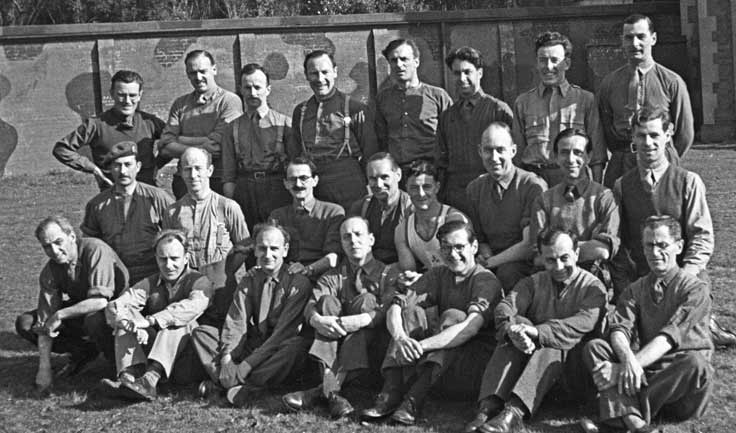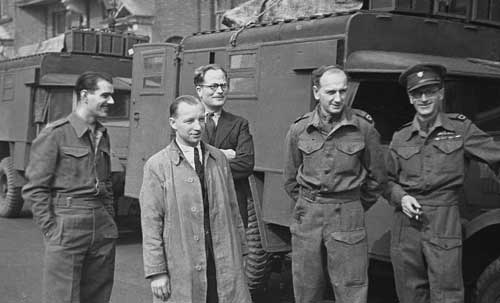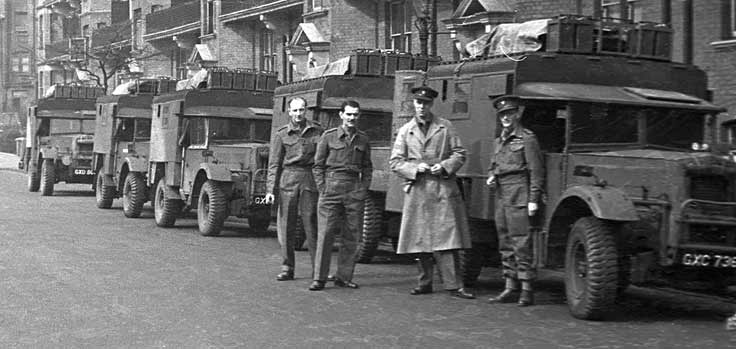Edward Ward had become the first radio reporter to send back live dispatches from a front line when Russia attacked Finland in 1939. He later worked in France, leaving Paris on the day that the Germans captured it. He then moved to North Africa, where Richard Dimbleby was already based, but was taken prisoner in November 1941. He was to be held for three years.
Godfrey Talbot arrived in Cairo in August 1942, replacing Richard Dimbleby. Army workshops converted a 30-hundredweight truck into a recording studio for him, and two RASC privates were provided to drive it and a staff car. Also with him were engineer "Skipper" Arnell and a liaison officer. The truck became known as "Belinda". Its sides could be pulled out to provide extra accommodation. If possible, the liaison officer would censor Talbot's scripts before they were recorded. Otherwise, recordings were checked and, if found to be dangerous to security, they would be destroyed. Discs that were passed were sent back by dispatch rider or plane to the Egyptian State Broadcasting studios in Cairo, there to be transmitted to London. In November 1942 Talbot was able to report on the Allies' first major victory of the war - the battle of El Alamein.
Frank Gillard took over from Godfrey Talbot to cover the last months of the North Africa campaign. The problem of getting recordings back to London was more difficult as the action moved westwards, though material would usually be on air within 24 hours of being recorded. In the last three months of fighting in Tunisia it was possible to send the discs via Algiers.
Moving on to Italy, Gillard had initially to use time on a US Army transmitter. Three of the recording trucks were in the country by November 1943. Godfrey Talbot was there early in 1944 and, reunited with "Belinda", reported the Allies' arrival in Rome on 5th June. The following day an even greater story unfolded, one for which the BBC had long been planning.
In March 1943 an exercise, code-named Spartan, was held in southern England to test the methods and equipment that would be used by an invasion force opening up the Second Front. The BBC took this opportunity to test its methods, too. Commentators prepared eye-witness accounts; the engineers recorded the sounds of mock-battle. The results were sent back to Broadcasting House where the material was censored and made into dummy programmes, all done as if live.
The results were heard by the Secretary of State for War and the C-in-C, Home Forces. They were sufficiently impressed to agree that the BBC should have the full co-operation of the Services during the invasion proper.
The BBC's plans nearly floundered when the Supreme Headquarters of the Allied Expeditionary Forces (SHAEF) was set up, and Eisenhower was appointed as Supreme Commander. At first SHAEF wanted to treat the BBC equally with other claimants on places in the Press pool, but the Corporation, supported by Montgomery, argued that it should receive special treatment as its broadcasts reached not only all of the English-speaking world but also the countries which the invasion would be liberating.
The idea of forming a War Reporting Unit took shape in January 1943. It was responsible for selecting and deploying correspondents, engineers and equipment, and providing material to all programmes which included war news. Staff were seconded from their normal departments.
Those new to war reporting went through a special training course. They were taught all manner of military skills, went on assault courses and learned to live rough. Some were attached to regular army units and shared their training. When the moment for action came, these men had already earned the army's respect.

Some of the correspondents and engineers at Wood
Norton.
Back row: Stewart McPherson, Major Bonus, C. Angell, F.B. Thornton, Wilfred Lindop, H.O.Sampson, Robert Barr, Captain Castle. Middle row: Colin Wills, Robert Dunnett, John Glyn-Jones, Richard North, Sgt Weston (instructor), Harvey Sarney, Ian Wilson, Pierre Lefevre. Front row: Stanley Maxted, C. Hindson, Sydney Gore, D.G. Snell, H. Shirley Long, R.D. Sigler, D.H. Fairley.
Back row: Stewart McPherson, Major Bonus, C. Angell, F.B. Thornton, Wilfred Lindop, H.O.Sampson, Robert Barr, Captain Castle. Middle row: Colin Wills, Robert Dunnett, John Glyn-Jones, Richard North, Sgt Weston (instructor), Harvey Sarney, Ian Wilson, Pierre Lefevre. Front row: Stanley Maxted, C. Hindson, Sydney Gore, D.G. Snell, H. Shirley Long, R.D. Sigler, D.H. Fairley.
Correspondents were trained to use the broadcasting equipment, in case their engineer was out of action; they received briefings explaining the needs of the various programmes and networks. They studied censorship, learning how to avoid mistakes which, once recorded on disc, would be hard to correct.

By November 1943 three of these recording trucks were in Italy and six more were ready for deployment. As D-Day approached five of the vehicles were handed over to correspondents. Type C disc cutters were aboard a warship and a merchant vessel and two more were with correspondents accompanying US forces.


